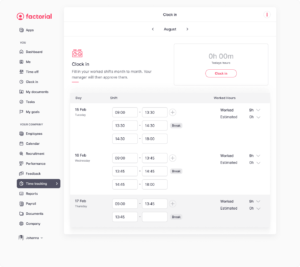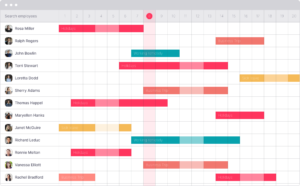In today’s fast-paced and evolving work environment, time tracking has become a crucial aspect of workforce management. It plays a pivotal role in ensuring efficiency, transparency, and accountability in the workplace. However, despite the advent of advanced technologies, a significant portion of organizations still rely on outdated manual time tracking systems. This article explores the impact of automation on time tracking through time tracking statistics and reveals how it can benefit both employers and employees.
TABLE OF CONTENTS
Collected time tracking statistics
What time tracking statistics show us
Time tracking tools for companies ✅
Collected Time Tracking Statistics
Here are eleven facts on time tracking. Take a look at them to get a picture of the US time tracking landscape. Does your company use time tracking to keep tabs on employee work hours and productivity? Maybe it’s time to consider it.
1. Over 1/3 of time tracking systems are outdated
According to this collected data, over 1/3 of time tracking systems are outdated. In the United States, a startling 38% of companies still use paper timesheets and punch cards for employee attendance tracking. The situation is even more pronounced in Canada, where a staggering 58% of businesses rely on these archaic methods.
2. Manual data input and data adjustments consume time
Approximately 38% of US employees continue to use paper timesheets and punch cards, leading to a significant drain on productivity. Deloitte reports that 50% of professionals who lack automated time tracking systems find manual data input and data adjustments to be the most time-consuming aspects of the process.
3. Inefficient systems lead to corrections
An alarming 80% of companies that still utilize paper time tracking systems report that they need to correct a staggering 80% of timesheets they receive. This inefficiency can be a costly burden on both time and resources.
4. Remote work is on the rise
The way we work is changing rapidly, with remote work becoming increasingly prevalent. Upwork projects that 40.7 million US professionals will be fully remote in the upcoming five years, comprising 27.7% of the workforce, while 20.4% will be partially remote (Upwork, 2021). The COVID-19 pandemic has further accelerated this shift, leading to an 87% increase in the number of remote workers (Business Wire, 2020).
5. Time tracking and productivity
Time tracking data reveals that the US economy loses a staggering 50 million hours of productivity per day due to unrecorded work activities. Activities such as unrecorded emailing alone can cost professionals up to $50,000 annually.
6. The impact of automation on businesses
Automation in time tracking offers numerous benefits to businesses. Up to 93% of US employees report that their paychecks are always delivered on time, thanks to business and productivity tools such as time tracking. Moreover, 31% of businesses have reported a positive increase in their ROI within just six months of implementing automated time tracking systems.
7. Curbing time theft
Time theft affects a substantial 75% of businesses. Implementing time tracking software can save organizations considerable resources, as one company demonstrated by saving more than $22,000 annually.
8. Satisfied with automation
The adoption of automation is met with satisfaction in the corporate world. A notable 73% of organizations express high levels of satisfaction with the returns they gain from automating their business tools and processes.
9. Unlocking productivity gains
The potential for increased productivity is significant. In 2016, the APA stated that companies have the ability to save up to 80% of their costs by automating their payroll processes. Mostly due to errors and human mistakes. This means your team can gain back their time to focus on more strategic tasks, save money, and provide more accurate time sheets to process payroll.
10. Employee tracking concerns
Interestingly, despite concerns about employer tracking, a large number of workers admit to using apps such as Google that already track their location. This highlights the need for open and clear communication, education, and transparency between employers and employees regarding tracking policies.
11. Factorial Time Tracking features saves companies time and money
Repetitive HR tasks like sending email reminders to employees to fill out their time sheets or requesting and approving PTO manually via email takes up dozens of hours per employee a month, which adds up to a lot of wasted time, costing your company a considerable amount of money. The ROI of a time tracking system like Factorial is easy to calculate – read our article on the costs and benefits of time tracking and leave management software to make an informed decision for your team and your company.
The statistics presented here emphasize the critical importance of modernizing time tracking systems in the workplace. Automation not only improves efficiency but also enhances transparency, eliminates time theft, and results in significant cost savings. As the workforce continues to evolve and adapt to new working conditions, investing in automated time tracking systems becomes increasingly essential for businesses to thrive in this dynamic environment.
What time tracking statistics show us
Time tracking software is invaluable just based on the sheer amount of time it can help you save by automating your HR processes. These tasks are necessary to making sure your company functions according to rules and regulations. However, they take up a lot of time that can be spent focusing on employee well-being, productivity and strategic decision-making instead.
What are these HR tasks and how can they be automated?
HR software with time tracking features like Factorial must include time tracking, shift management, and leave management features in order to cover the basic time tracking needs of your company. Let’s take a quick look at these tools.
Time tracking features
Factorial provides all employees with an easy-to-access platform. Employees gain access to a dashboard that shows the time they have worked that day after clocking in, as well as a weekly and monthly view of their hours worked.
![]()
Clock in features
Employees can clock in from the platform or even their phone via the mobile app. Managers receive optional notifications via email or mobile app of clock in and clock out activity. Using the clock in and time tracking features allows employees to fill their timesheets automatically.

Managing time off requests
Factorial gives employees the power to submit their time off requests automatically through the platform, and managers the freedom to approve or deny these requests with a few simple clicks. Accumulated PTO is easy to assess via the separate tracking screens.

Shift scheduling features
Shift schedules are easy to create thanks to Factorial’s time tracking features, PTO tracking featues, and pre-set employee work schedule policies. Taking into account the amount of hours employees are required to work, upcoming holidays and requested days off, scheduling becomes a breeze.

Calendar view
Factorial makes it even easier to see who in your team is working and when they have upcoming scheduled leave days. Just switch to the calendar view to see and plan your workload and employee schedule accordingly.

If these statistics peaked your interest and you want to explore time tracking options, Factorial offers a 14-day free trial and even offers a free demo call. Click the banner below to sign up!




